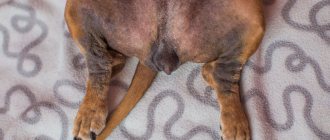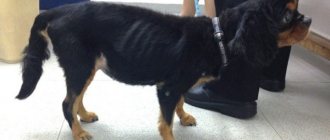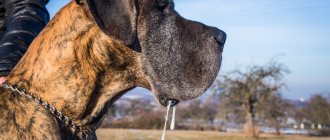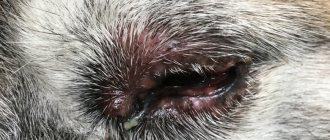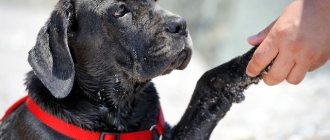Skin diseases in dogs occupy a leading place in veterinary medicine today. Almost every pet has suffered from dermatitis or allergies at least once in its life.
There are many factors that provoke the development of skin disease: poor ecology, not always competent breeding work, poor quality care for the animal, and much more. Symptoms of skin diseases cause great discomfort to the dog, so treatment should be started without delay.
Causes of the disease
Skin lesions can be parasitic, allergic, fungal and bacterial.
The main causes of skin pathologies include:
- changes in hormonal levels;
- deficiency of vitamins in the body;
- disruption of the activity of internal organs and systems;
- poor care and maintenance;
- poor quality food;
- genetic predisposition.
The list of skin diseases is very extensive, let’s look at the most common of them:
- Dermatophytosis (ringworm in dogs). Fungal infection.
- Pityrosporosis (mycosis). The cause of infection is yeast fungi.
- Ectoparasite lesions, flea dermatitis (fleas, lice eaters, ticks).
- Allergies are the body’s immune response to external irritants (chemicals, detergents, flea collars, etc.).
- Pyoderma. Purulent skin lesions provoked by the activity of pathogenic bacteria.
- Atopic dermatitis. Provoking factors - climatic conditions, poor care, unbalanced diet, etc.
- Allergic dermatitis. The body's reaction to parasite bites.
- Sarcoptic mange (scabies). The causative agent is the scabies mite.
- Seasonal dermatitis. The reason is a malfunction of the immune system. The etiology of the disease is not fully understood.
- Skin oncology.
There is no single treatment for skin diseases. The doctor prescribes it after making a specific diagnosis.
Types of skin diseases in dogs
Parasites. Scabies mites are found quite often among our smaller brothers and statistics show that scabies in pets that have been examined by a specialist is a systematic phenomenon. There are two forms of manifestation of skin diseases in dogs.
Sarcoptic mange. The carriers of this infection, ticks, and their offspring, feed on the epidermis and move under the skin through a kind of “undermining”. They are not easy to spot, and each individual lives for approximately twenty-one days. Sarcoptic mites, finding themselves in an unnatural environment for them, die within one to two days.
It is possible to verify the presence of parasites in an animal by taking a skin sample from the irritated area. Ticks live where it is dry, mainly on the paws, head or torso. If your dog's hair falls out, skin pigment darkens, wrinkles and dandruff appear, you should sound the alarm. The dog is constantly itching, thereby combing the infected areas.
Sarcoptic mange can be treated by bathing the animal in special decoctions, using injections and taking oral medications. Infection of the owners is possible, which can manifest itself in itching of parts of the body that come into contact with the sick pet.
Demodecosis. It is also called red scabies. This form is much easier to detect, but it is also more painful to tolerate. An alarm signal will be small inclusions with a rough surface dispersed over the head, paws and body. If you don't monitor your dog's behavior, he may scratch the skin off the itchy spots.
There is an opinion that demodectic mites are found only on yard dogs, but this is a myth. In most cases, the number of parasites on the animal’s body is quite large and their presence is easy to determine. But we must take into account that confronting the disease is rarely fruitful. Previously, this disease was considered incurable.
It is not difficult to find a clinic that is ready to help in the fight against this difficult problem. But the difficulty is that red scabies can spread to internal organs. The result is also difficult to achieve if the mite has settled in the root system of the coat.
To get rid of ticks, the animal is shaved - this allows the drugs to penetrate the inner layers of the skin. With timely medical care and following treatment procedures, recovery will occur within a couple of weeks.
Which breeds are more susceptible
The skin disease can be diagnosed in any dog, regardless of gender and age. However, there is a natural predisposition, according to which various skin pathologies can be found in representatives of certain breeds much more often than in other dogs.
For example, acanthosis nigricans is diagnosed primarily in short-haired breeds, most often in dachshunds. Poodles, pinschers, dachshunds, and whippets suffer from hypotrichosis. In these dogs, hairless areas are located on the dewlap, on the outside of the ears.
Bulldogs, St. Bernards, Chow Chows, Spaniels, Pekingese, and Pugs are characterized by inflammation of the skin folds. Samoyeds, Dalmatians, Retrievers, and Dobermans most often suffer from pigmentation disorders. Seborrhea is mainly observed in German shepherds, Dobermans, spaniels, schnauzers, atopic dermatitis - in bulldogs, boxers, pugs, sharpeis, setters, and labradors.
Useful video
Watch this video about shedding in dogs:
Similar articles
- Ringworm in dogs: what it looks like, symptoms...
Ringworm in dogs occurs due to parasites. The initial stage may go unnoticed, with symptoms appearing after a few days. Read more - Baldness in a dog (back, tail): causes, treatment
Causes of baldness in dogs. Veterinary specialists and experienced dog breeders ... The cause of extensive bald spots in an animal is often helminthic infestations. Read more
- How to remove fleas from a dog, how to make it popular...
Advice from a veterinarian on how to remove fleas from a dog, taking into account his health and age. Author of the article: Lyubov Ilyina (veterinarian). Read more
- Goiter in a dog: what to do if endemic...
A dog may develop a goiter due to a lack of iodine. ... A sick dog has tousled, dry hair with bald spots. Read more
- Uterine prolapse in a dog: causes in nulliparous bitches, in…
Causes of uterine prolapse in dogs and ways to restore the organ. Author of the article: Lyubov Ilyina (veterinarian). Read more
Main symptoms
Each skin disease has its own symptoms, but there are also common symptoms that indicate the presence of skin pathology in a pet. These signs include:
- Severe itching. The dog is constantly itching, literally tearing its body with its claws. As a result, wounds, abrasions and other damage form on the skin.
- Shedding not associated with seasonal changes, alopecia.
- Dandruff, seborrhea.
- Spots, redness, pigmentation on the skin.
- Ulcers, abscesses, swelling, acute weeping eczema.
Fungal diseases, as a rule, are not accompanied by itching, burning, or redness of the skin. A characteristic sign is the appearance of bald patches.
With mycosis caused by yeast fungi, the dog experiences baldness, inflamed areas of the skin, and changes in hair growth.
If a dog is bitten by blood-sucking insects, it experiences severe itching and itching. Scratching causes secondary infection and provokes the development of infected dermatitis.
Briefly about the main thing
- There are a lot of diseases that cause pathological processes on the skin and they can only be distinguished from each other through laboratory tests.
- If you notice any deviation in your dog’s condition, this is a reason to contact a specialist, because if you hesitate, further treatment will take much longer.
- Be sure to examine your pet for any abnormalities.
- Approach your dog's nutrition with great responsibility.
Diagnostics in a veterinary clinic
Diagnosis of skin diseases is associated with certain difficulties, since pathologies have many similar signs. To make an accurate diagnosis, the veterinarian needs to conduct a visual examination of the animal, collect anamnesis and perform a number of necessary diagnostic tests.
If allergic dermatitis is suspected, the doctor interviews the owner to identify the etiology of the allergen. In particular, he is interested in the symptoms of the disease, the frequency of relapses, information about the parents, feeding and maintenance features, walking, previous illnesses, etc.
The diagnostic approach depends on a detailed medical history in conjunction with physical and dermatological examination. Mandatory diagnostic methods include:
- blood tests (general, biochemical);
- stool and urine analysis;
- skin scraping;
- trichogramma;
- cytology;
- mycological studies;
- PCR diagnostics of pathogens.
The presence of lichen is determined by using a UV lamp. If cancer is suspected, a skin biopsy is performed.
Prevention
The following tips and recommendations from veterinary specialists will help the owner prevent the development of problems with the pet’s coat:
- Daily inspection of the animal's skin and fur.
- Regular brushing of the dog with properly selected combs and combs, especially during seasonal shedding.
- The use of special shampoos and conditioners designed to care for the hair of animals of a particular breed.
- Prevention of stressful situations in dogs.
- A balanced diet enriched with B vitamins, biotin, sulfur, zinc, selenium.
We recommend reading about pyoderma in dogs. From the article you will learn about the reasons for the development of pyoderma, types of pathology, symptoms, and treatment methods.
And here is more information about ringworm in dogs.
The appearance of bald spots on the body, limbs and face of a pet can occur for many reasons. Veterinary specialists distinguish between hormonal and non-hormonal factors in the development of alopecia in dogs. Treatment depends on the root cause of the pathology and is complex. The owner should pay special attention to a balanced diet and proper hygienic care of the animal’s coat.
Treatment and prognosis
There is no single treatment regimen for skin pathologies. For each disease, certain principles of therapy have been developed, which are actually based on eliminating the problem. If the disease is caused by a fungal infection, a course of broad-spectrum antibiotics (Tsiprovet, Cephalen, Xiclav, etc.) is prescribed.
In addition, general treatment procedures are carried out, the purpose of which is to affect the affected areas of the skin. For this, anti-inflammatory and antiseptic solutions, ointments, creams (Migstim, Diclorex, Phytoelita, etc.) are used.
To cleanse and moisturize the skin, therapeutic and prophylactic shampoos (Geksovet, Ketovet, Meladerm) are used.
Since many skin pathologies, in particular allergies, arise due to a weakened immune system and a decrease in the body's protective functions, the principles of therapy are based on increasing the immune response and getting rid of allergens. So, if a dog has a food allergy, a strict hypoallergenic diet with the addition of vitamin and mineral supplements is recommended (only after consulting a veterinarian).
For itching, antihistamines (Zyrtec, Claritin, Lominal, Telfast, Gismanal, Trexil) and antipruritic ointments are prescribed. Often itching is accompanied by eczema. For weeping skin lesions, drying ointments and creams are indicated, and for dry ones, moisturizing ones are indicated.
If the cause of a skin disease is insect bites, antiparasitic treatment is mandatory using drops, sprays, and shampoos. In this regard, drugs such as Inspector, Lawyer, Frontline, and Certificate have proven themselves well.
Atopic dermatitis in dogs - treatment: corticosteroids (Prednisolone, Dexamethasone, etc.), which suppress the inflammatory process and eliminate characteristic symptoms.
As for the prognosis, most skin diseases respond well to treatment, provided that it is started in a timely manner. Chronic diseases are much more difficult to treat. You need to understand that, most likely, skin pathologies such as allergies and chronic dermatitis will haunt your pet throughout his life with periods of exacerbations and remissions.
However, in some cases, when the itching becomes resistant to treatment, or in case of skin cancer, the only humane way to save the animal from suffering is euthanasia.
Bacteria infection
Pyoderma is a bacterial inflammation of the skin that is more common than others. Microorganisms penetrate into the inner layers of the skin. The main causative agent is considered to be the bacterium Staphylococcus intermedius. In moderate quantities, it is present everywhere on the skin, but when the animal gets into unfavorable conditions, staphylococcus progresses and causes inflammation. In this case, symptoms are noticeable on the thighs or around the anus.
When bacteria multiply, their foci appear on the head and face, near the mouth and even in the oral cavity. Puppies are also susceptible to skin diseases of this type: in this case, small dark spots appear on the body. In the absence of proper treatment, the infection deepens, including the hair follicles.
The skin is treated with antiseptics, baths and antibiotics are prescribed. Ignoring the disease is fraught with the occurrence of abscesses that negatively affect the condition of the blood and hemoglobin levels.
Modern medicine is testing antibiotics in an attempt to improve the results of treatment of pyoderma. You can reduce pain by preventing it from injuring irritated skin.
What to do at home
The owner is required to strictly follow the doctor's recommendations. You cannot self-medicate, otherwise irreparable harm will be caused to your pet’s health. Do not exceed the dosage, as this will lead to side effects and complications. You can alleviate the dog’s suffering using traditional methods, but replacing conservative therapy with them is not only ineffective, but also dangerous.
Medicinal plants such as calendula, chamomile, and echinacea are widely used to treat skin diseases. Herbal decoctions and teas are used as lotions and compresses that eliminate symptoms and accelerate skin regeneration.
The use of aloe, which can be called a unique plant, is very effective for treating wounds, rashes, eliminating pain, discomfort and itching. Aloe leaf should be scrolled through a meat grinder or crushed in a blender, squeeze out the juice and soak gauze with it. A compress with aloe is applied to the damaged areas and left for several hours.
During treatment, the dog should be provided with the most comfortable living conditions. In the room where it is kept, it is necessary to wash the floor every day and ventilate it frequently.
Recommendations for caring for a sick pet
Personal hygiene is mandatory in case of infectious diseases, along with patient isolation. Immediately after contact with a sick animal, it is necessary to use disinfectants; it is possible to take vitamins and antifungal drugs.
Regular wet cleaning of the premises is necessary. Items that the pet has come into contact with should be disposed of whenever possible.
The diet should be balanced; the benefits of vitamins have already been mentioned above. It is advisable to confirm the diet with your doctor.
Be sure to follow all veterinarian instructions and monitor your sick pet.
Other pathologies
The latter group includes eczema, atopic dermatitis and seborrhea. Photos of dogs with these skin diseases can be seen below.
Eczema
Owners rarely notice eczema at an early stage, since all the changes that occur are masked by the fur. The symptoms of this inflammatory disease depend on its form:
- getting wet
. Accompanied by severe pain, chills and fever. Numerous ulcers periodically break out, moisturizing the skin with their contents. Dried exudate sticks the fur together, giving it an unkempt appearance. Due to ulceration, the lesion rapidly increases in size.
- Dry
. The epidermis covers the rash or papules. They itch but are not painful. Due to scratching, the skin becomes very flaky, becoming covered with dandruff and seborrheic plaques. The fur slowly thins and then begins to fall out in clumps.
The disease is not transmitted to humans or other domestic animals. First of all, it is dangerous for the patient, since the wounds on his body are very attractive to pathogenic microorganisms.
Atopic dermatitis
Atopy is a type of allergy that occurs due to genetic predisposition. Most often it appears at the age of 1-5 years and is accompanied by:
- unbearable itching;
- baldness of certain areas of the body;
- thickening of the skin and disruption of its pigmentation;
- numerous suppurations at the site of scratching.
In rare cases, atopic dermatitis leads to otitis media and lameness. This disease is characterized by a series of remissions and exacerbations. Depending on the severity of the course, attacks can occur every six months, every month or on an ongoing basis.
Seborrhea
Most often, seborrhea affects the line along the spinal column, paws and abdomen. The secretion that accumulates there gives the fur an untidy appearance and an unpleasant odor.
Depending on the cause of the problem, dandruff can be dry or oily. In the first case, incorrectly selected shampoos and too frequent washing are to blame, removing the protective layer from the skin. In the second case, the problem lies in the too intense work of the sebaceous glands.
